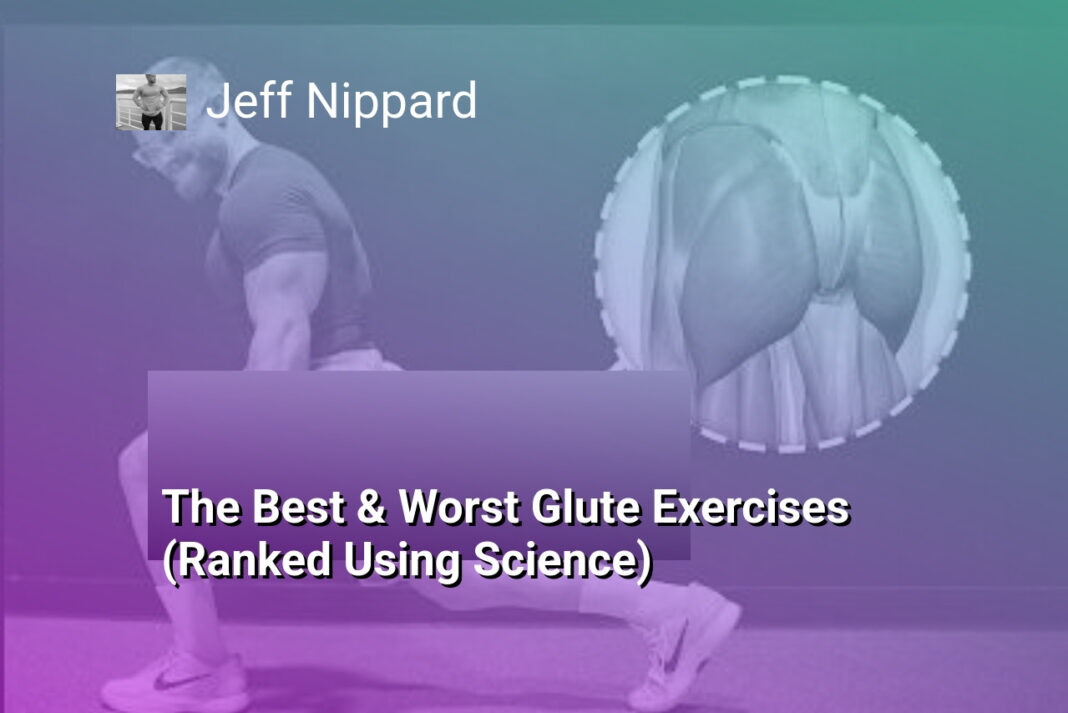The Bottom Line:
- I discovered that glutes are not just aesthetic muscles but critical for overall body strength and performance, comprising three distinct muscle groups with unique functions.
- Through a comprehensive exercise ranking system, I learned that not all glute exercises are created equal, with walking lunges emerging as the top-tier movement for muscle development.
- My research revealed that machine-based and unilateral exercises like the Nautilus Glute Drive and Single Leg Dumbbell Hip Thrust are exceptionally effective for targeted glute activation and growth.
- I realized nutrition is paramount in muscle building, emphasizing the need for strategic caloric intake and protein consumption to support intense training efforts.
- By understanding the nuanced approach to glute training, I concluded that a diverse exercise routine combining multiple movements is key to achieving comprehensive muscle development and optimal performance.
Why Glute Muscles Matter for Physique and Performance
The Muscular and Functional Significance of Glutes
The gluteal muscles are far more than just an aesthetic feature; they represent a critical component of human biomechanics and athletic performance. As the largest muscle group in the human body, the glutes play a pivotal role in fundamental movements like walking, running, jumping, and stabilizing the pelvis. Their significance extends beyond simple visual appeal, encompassing critical functional capabilities that impact overall physical performance and injury prevention.
Biomechanical Power and Athletic Potential
Strong glute muscles directly correlate with enhanced athletic performance across multiple disciplines. They generate substantial power during explosive movements, facilitate efficient force transmission through the kinetic chain, and provide essential stabilization for complex athletic maneuvers. Athletes with well-developed glutes demonstrate superior acceleration, vertical jump height, and rotational power. Moreover, robust gluteal muscles contribute to improved posture, reduced lower back strain, and increased overall movement efficiency.
Comprehensive Muscular Development and Injury Mitigation
Developing the glutes isn’t just about aesthetic goals; it’s a strategic approach to comprehensive muscular development and injury prevention. The three primary glute muscles – gluteus maximus, gluteus medius, and gluteus minimus – each serve unique functional roles. The gluteus maximus generates powerful hip extension, the gluteus medius provides critical lateral stability, and the gluteus minimus supports intricate movement patterns. Targeted glute training can mitigate common issues like lower back pain, knee misalignment, and muscular imbalances that often result from sedentary lifestyles or unbalanced training approaches. By prioritizing holistic glute development, individuals can enhance their physical resilience, optimize movement mechanics, and create a foundation for superior athletic performance across diverse physical domains.
Glute Muscle Anatomy: Understanding Your Lower Body Powerhouse
The Three-Muscle Composition of Your Glutes
The gluteal muscle group is a complex system comprised of three distinct muscles, each playing a critical role in lower body biomechanics and movement. The gluteus maximus, the largest and most powerful muscle, serves as the primary driver for hip extension and generates substantial force during activities like sprinting, jumping, and climbing. This muscle is responsible for the overall shape and size of your buttocks and contributes significantly to athletic performance and aesthetic development.
Functional Roles and Movement Patterns
The gluteus medius and minimus, while smaller, are equally important for lower body stability and movement precision. The gluteus medius, positioned on the outer hip, plays a crucial role in lateral movement, hip abduction, and maintaining pelvic alignment during single-leg activities. Its strength is paramount for preventing knee valgus and maintaining proper movement mechanics during complex exercises like squats, lunges, and running. The gluteus minimus, the smallest of the three muscles, works synergistically with the medius to provide hip stabilization and support rotational movements.
Biomechanical Significance and Performance Implications
Understanding the intricate anatomy of the glutes reveals why targeted training is essential for both athletic performance and injury prevention. These muscles are not just aesthetic components but fundamental to human movement efficiency. Weak or underdeveloped glutes can lead to compensatory movement patterns, increased injury risk, and reduced overall athletic potential. Proper engagement of the gluteal muscles involves complex neuromuscular coordination, requiring precise activation techniques and progressive resistance training strategies that challenge the muscles through multiple planes of motion and varying resistance profiles.
Top-Ranked Glute Exercises for Maximum Muscle Growth
Powerhouse Movements for Glute Hypertrophy
Walking lunges stand out as the most comprehensive glute exercise, delivering exceptional muscle activation and growth potential. By dynamically engaging multiple muscle fibers through continuous movement, walking lunges create substantial metabolic stress and mechanical tension. Performing these with moderate to heavy dumbbells can exponentially increase muscle recruitment and stimulate significant hypertrophy in the gluteus maximus and medius.
Machine and Isolation Techniques for Targeted Growth
The Nautilus Glute Drive represents a revolutionary machine for precise glute development. Its biomechanical design allows for optimal muscle tension and controlled range of motion, making it superior to traditional bodyweight alternatives. Single-leg dumbbell hip thrusts complement machine work by introducing unilateral training, which helps address muscle imbalances and enhances overall glute symmetry. These exercises create targeted muscle stress that promotes localized hypertrophy and improves neuromuscular coordination.
Compound Movements for Comprehensive Development
Deep squats and Romanian deadlifts provide exceptional full-body stimulus with significant glute engagement. When performed with proper technique and progressive overload, these compound movements stimulate massive hormonal responses that support muscle growth. The Romanian deadlift particularly excels at targeting the lower glutes and posterior chain, creating substantial muscle tension through eccentric loading. By incorporating these exercises with strategic rep ranges between 6-12 and progressively increasing weight, athletes can achieve remarkable glute development while simultaneously improving overall strength and functional movement patterns.
Avoiding Ineffective Glute Training Techniques
Common Mistakes in Glute Training Methodology
Many individuals unknowingly sabotage their glute development by implementing ineffective training strategies. One primary error is relying exclusively on bodyweight or low-resistance exercises like donkey kicks and fire hydrants, which generate minimal muscle tension and provide limited progressive overload potential. These movements might create a burning sensation but fail to stimulate meaningful muscle hypertrophy or strength gains.
Misunderstanding Exercise Selection and Progression
Proper exercise selection is critical for glute development. Trainees often gravitate towards exercises that feel comfortable rather than those scientifically proven to maximize muscle recruitment. For instance, frog pumps, while potentially useful as high-repetition finishers, lack substantial loading capacity and cannot sustainably drive muscle growth. Similarly, machine-based isolation movements frequently underperform compared to compound exercises that engage multiple muscle groups simultaneously.
Neglecting Comprehensive Movement Patterns
Effective glute training requires understanding complex movement patterns involving hip extension, abduction, and rotation. Simply performing repetitive, single-dimensional movements like traditional squats without proper depth or loading will significantly limit muscle development. Successful glute training demands strategic exercise variation, progressive overload, and movements that challenge the muscles through multiple planes of motion. Incorporating exercises like walking lunges, Romanian deadlifts, and single-leg hip thrusts provides a more holistic approach to stimulating comprehensive glute muscle growth and functional strength.
Nutrition and Recovery Strategies for Optimal Glute Development
Protein Intake and Muscle Protein Synthesis
Optimal glute development requires strategic protein consumption to support muscle growth and recovery. Aim for 1.6-2.2 grams of protein per kilogram of body weight daily, with a focus on complete protein sources that provide all essential amino acids. Leucine-rich foods like chicken, fish, eggs, and whey protein are particularly effective in stimulating muscle protein synthesis. Timing protein intake around workouts can enhance muscle recovery and growth, with research suggesting consuming 20-40 grams of protein within 30 minutes post-exercise maximizes muscle protein synthesis and supports glute muscle repair.
Caloric Management and Nutrient Timing
Muscle growth requires a carefully managed caloric surplus, typically 300-500 calories above maintenance level. For glute development, macronutrient balance is crucial. Carbohydrates play a critical role in replenishing glycogen stores and supporting intense training sessions, while healthy fats contribute to hormonal balance and overall recovery. Complex carbohydrates like sweet potatoes, brown rice, and quinoa provide sustained energy for high-intensity glute workouts. Additionally, incorporating nutrient-dense foods rich in micronutrients such as zinc, magnesium, and vitamin D can support muscle recovery and overall metabolic function.
Supplementation and Recovery Optimization
Strategic supplementation can enhance glute muscle development and recovery. Creatine monohydrate has been extensively researched and proven to increase muscle strength and size, potentially improving glute muscle performance. Omega-3 fatty acids can help reduce inflammation and support muscle recovery, while branched-chain amino acids (BCAAs) can minimize muscle breakdown during intense training. Adequate hydration is equally important, with recommendations of 30-35 ml of water per kilogram of body weight to support muscle function, nutrient transport, and overall metabolic processes. Implementing proper sleep hygiene, aiming for 7-9 hours of quality sleep, further supports muscle recovery and hormonal balance critical for optimal glute muscle growth.





